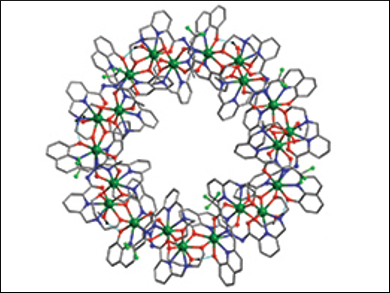Molecular magnets have become a hot topic since the discovery of single-molecule magnetism. These materials have different properties to classical bulk magnets, and as such have potential applications in many fields, including high-density information storage, quantum computing, spintronics, and magnetic refrigeration.
Paul Kögerler, RWTH Aachen University, Germany, Enrique Colacio, Universidad de Granada, Spain, Vadapalli Chandrasekhar, Indian Institute of Technology, Kanpur, and National Institute of Science Education and Research, Bhubaneswar, India, and colleagues have investigated dysprosium molecular magnets. The team’s aim was to probe how subtle changes in reaction conditions can lead to complexes with varying structures. Through small changes to their synthesis, they produced four different clusters containing 2, 4, 6, and 21 dysprosium atoms respectively.
The Dy21 cluster is of particular interest as it forms a nanowheel (pictured). Single-stranded lanthanide nanowheels are very rare and this example is bigger than the largest homometallic wheel structure reported to date, which contained 18 gadolinium atoms [1]. Magnetic property measurements show that three of the four new materials exhibit slow relaxation of the magnetization, which is an indicator of single-molecule magnetism. The work demonstrates how small alterations of the synthesis can lead to materials with diverse structures and properties.
- Homometallic DyIII Complexes of Varying Nuclearity from 2 to 21: Synthesis, Structure, and Magnetism,
Sourav Biswas, Sourav Das, Joydev Acharya, Vierandra Kumar, Jan van Leusen, Paul Kögerler, Juan Manuel Herrera, Enrique Colacio, Vadapalli Chandrasekhar,
Chem. Eur. J. 2017.
DOI: 10.1002/chem.201700471
[1] A single-stranded {Gd18} nanowheel with a symmetric polydentate diacylhydrazone ligand, K. Wang, Z.-L. Chen, H.-H. Zou, K. Hu, H.-Y. Li, Z. Zhang, W.-Y. Sun, F. P. Liang, Chem. Commun. 2016, 52, 8297–8300. DOI: 10.1039/C6CC02208A
